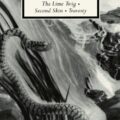The Previous Everyday: Nicola Griffith’s Hild

In Reading in Detail: Aesthetics and the Feminine, Naomi Schor explores the connection between detail and female identity in art and literature. Schor argues that detail can be threatening in its “tendency to subvert an internal hierarchic ordering of a work of art which clearly subordinates the periphery to the center.” Detail refocuses attention on the marginalized, the seemingly insignficant, the banal. Drawing upon Schor’s work, Ruth Hoberman, in Gendering Classicism, argues that by focusing on the details of the “previous everyday,” female historians and historical novelists resist the male-dominated master narratives of history from which women have largely been excluded. An attention to the realistic detail of everyday life robs historical narratives of what Hayden White called “the odor of the ideal.”
Virginia Woolf’s early story, “The Journal of Mistress Joan Martyn” (1906), suggests how a woman might approach the writing of history. The story begins with an introduction by Miss Rosamond Merridew, a fictional historian who travels the length and breadth of England in search of documents that illuminate the medieval system of land tenure. She addresses the topic not through theory and synthesis, but through attention to “fitful” and “minute” details that illuminate everyday life in the Middle Ages. Instead of writing history from the top down, she writes it from the bottom up, beginning with attention to specific detail:
A sudden light upon the legs of Dame Elizabeth Partridge sends its beams over the whole state of England, to the King upon his throne: she wanted stockings! and no other need impresses you in quite the same way with the reality of medieval legs; and therefore with the reality of medieval bodies, and so, proceeding upward step by step, with the reality of medieval brains; and there you stand at the center of all ages: middle, beginning, and end.
This is inductive history, with the narrative constructed of specific details from everyday life that illuminates the larger patterns of history. Merridew describes her method in the book The Manor Rolls, in which she attempts to show, “as vividly as in a picture, some scene from the life of the time.” She knocks at a serf’s door, goes on a journey with the Lord of the Manor, and joins Dame Elinor as she bends over her stitching. Her procedure is that of the historical novelist, drawing on research to re-imagine the details of the “previous everyday.”
The same method is followed by economic historian Eileen Power in her 1924 volume, Medieval People, which attempts to reconstruct the daily life of ordinary people in the Middle Ages. She quotes Lord Acton that “the great historian now takes his meals in the kitchen,” and writes that her own book “is chiefly concerned with the kitchens of History.” Power begins with a “visit” to a country estate near Paris in the early ninth century, and follows the daily routine of the peasant Bodo and his wife Ermentrude.
In Woolf’s story, Miss Merridew stumbles upon a decaying country house in Norfolk whose current resident shows her the diary of one of his ancestors, Mistress Joan Martyn, resident of the estate in the late fifteenth century. The landowner has a detailed knowledge of his family history—“any fool knows his own ancestors,” he tells his wife—and thinks of his forefathers and foremothers as living presences that keep him company in the lonely farmhouse. That same feeling for family and home is contained in the diary of his ancestor Mistress Joan, who speaks of being “wedded to this clump of earth,” and who ends her diary with a gesture of affection for her own ancestors buried in the local church.
Joan is proud of her ability to read and write, an ability that connects her with her ancestors through her “favourite task” of spelling out their names on the tombs in the church. She keeps her diary for a year despite a feeling that “there is nothing in the pale of my days that needs telling.” Reading and writing, along with a feeling of connection to home, are the threads that bind together her writing. They connect Joan both to ancestors lying in the church and to the descendants who will read her words.
When she comes to the end of her diary, Joan confesses that “if I ever write again it shall not be of Norfolk and myself, but of Knights and Ladies and adventures in strange lands.” Although Mistress Joan’s diary provides the historian with a document that brings to life the “previous everyday,” Joan herself is attracted to history as a chronicle of romance and adventure. One strand from the Journal of Mistress Joan Martyn leads to the work of historians like Eileen Power and Laurel Thatcher Ulrich; the other strand leads to historical fantasy.

Hild
by Nicola Griffith
$18.00, Softcover
Picador, 2014
In her beautiful and powerful new novel, Hild, Nicola Griffith expertly weaves together careful research and a brilliant historical imagination with the wonder and excitement of a great fantasy novel. Hild was a real seventh-century Anglo-Saxon princess who became the influential abbess of Whitby, and who was later venerated as St. Hilda. Bede is our primary source for the outline of her life. He tells us that she was the daughter of Hereric of Deira, the nephew of King Edwin of Northumbria. After her father died in exile, Hild became attached to her uncle’s court, and was among the members of the court who were baptized by Paulinus, the first Archbishop of York, when Edwin converted to Christianity around 627. Though Bede provides scant information about Hild’s early life, Griffith creates a story rich in detail about a strong and observant girl who becomes one of the most powerful women of her time.
Hild is Griffith’s sixth novel. Her five previous include science fiction titles and a mystery series, and she has won six Lambda Literary Awards. Equally at ease in any number of fictional worlds, Griffith draws on her skill as a writer of action and mystery to craft the tough, observant Hild, and on her experience as a writer of science fiction in constructing a believable world of such familiar strangeness.
In the novel, Hild derives her power and influence in Edwin’s court from her minute attention to detail and her ability to fashion a convincing narrative out of those details. Picking up details in the natural world enable her to forecast the weather, for instance. The flight of birds tells her that a storm is coming, that the mild November will soon become harsh winter. From observing the behavior of men, and listening attentively to their words, Hild is able to understand their motivations and predict their actions. Through her ability to interpret the significance of such minutiae, Hild becomes King Edwin’s seer—a powerful advisor whose influence threatens, and is threatened by, the severe and ambitious Bishop Paulinus, also known as the Crow.
Virginia Woolf’s Mistress Joan, on the pilgrimage to the shrine of Our Lady of Walsingham, becomes absorbed in the details of her surroundings and in the “strange, merry stories” her fellow pilgrims have to tell. But as she approaches the statue of the Virgin at the top of the hill, Joan’s mind becomes filled “with an image that was so large and so white that no other thought had room there.” Christianity, it would appear, whites out the detail. This totalizing energy becomes the root of the tension between Hild and Paulinus: between Hild’s feminine attention to detail and the Crow’s single-minded masculine devotion to an idea—the conversion of Britain to the master narrative of Christianity. Hild’s power, based on observation and interpretation of a multiplicity of details, threatens to subvert the Crow’s authority, which is based on enforcing a single dominant ideology.
In Medieval Women, Power writes that “the characteristic medieval attitude [toward women] could only have arisen in an age in which clerical and aristocratic groups were able to impose their point of view on society. If public opinion had been formed from the bottom upward, rather than from the top downward, the prevalent dogma might have been different.” Hild offers a tantalizing vision of a different world, one shaped by power structures based in the feminine focus on detail, variety, and cohesion, rather than assertive hegemony. At the same time, however, Griffith portrays Hild as able to hold her own in male-dominated circumstance: she becomes a skilled and ruthless warrior, and a leader of men. Eventually, as the historical record tells us, Hild even becomes the influential abbess of a double monastery—a self-sustaining religious community of both women and men with a woman at its head. Abbess Hild will wield great power, but only within the hierarchical structure of the Crow’s Church.
By the seventh century, Britain had been divided into kingdoms large and small, Anglo-Saxon and Celtic, among which ambitious kings engaged in a struggle for overlordship of the entire island. Like her ambitious uncle, King Edwin, who envisions a Britain unified under his benevolent dominion, Hild seeks to create unity. When she joins her uncle’s men in establishing control over the small kingdom of Elmet after the death of its ruler, she tells the people that “in Elmet now there were no more Anglisc [Anglo-Saxons], no more Loid [the Celtic tribe native to Elmet], there were only Elmetsætne [people of Elmet].”
Hild has a string of carnelian beads*, a gift from a princess of Rheged, which she uses as a kind of abacus to organize her thoughts and keep track of the plots swirling around her uncle and herself. One bead is Osric, Edwin’s cousin. This larger bead is Penda, king of Mercia. But her advisor, the Irish priest Fursey, draws her attention to a small yellow bead, “the brightest bead of all,” and tells her that it represents Christ. “He is everywhere,” Fursey says.
But the future abbess has yet to understand the powerful unifying force of the Church. Her own desire for an inclusive sense of belonging springs from an attachment to family and home. She has a complicated affection for her ambitious mother, Breguswith, and her sister Hereswith, and a closer and deeper bond with her childhood companion Cian. As a member of her uncle’s itinerant court, Hild dreams of settling down in a place where she knows her surroundings and feels the affection of old associations. The novel begins with Hild listening to the jackdaws “changing their calls from ‘Outward! Outward!’ to ‘Home now! Home!’”
Hild’s close attention to detail is an outgrowth of her powerful sense of place, her desire to know and feel kinship with every tree and bird and blade of grass in the place where she lives. In one episode, she and her gemæcca (companion) Begu walk along a river at dusk. Hild takes Begu to the water’s edge and promises to show her jewels “more beautiful than you’ve ever seen.”
At the river’s edge, the moolight was brighter. Hild found the overhang where the fern and thung flowers and primroses grew, the stick of ash poking from the water. She pulled it out carefully.
It glistened with fish eggs, perfect as the most delicate pearls on the queen’s veil.
These descriptions of the natural world are never gratuitous. They demonstrate the working of Hild’s mind while texturing the reality in which she lives. The novel is packed with political intrigue, battles, and blood. But, like Hild herself, Griffith’s writing derives its power from its attention to detail, from the rich evocation of the changing seasons, the close attention to the natural world and to the work of ordinary men and women. She describes weaving, the making of cheese, the planting and plaiting of hedges, the horrors of battle, and with apparent effortlessness transforms her careful historical research into a vivid depiction of life itself.
Like Woolf’s “sudden light,” Hild’s story illuminates seventh-century Britain from the bottom up, the smallest details, like the jewel-like fish eggs in the river, to the most far-reaching sociopolitical movements.
* Correction: an earlier version of this review misidentified the beads as amber.
About Rob Hardy
Rob Hardy has been a stay-at-home father, a teacher, a researcher for The Writers’ Almanac, a school board member, and an adult advisor to the Northfield Skateboard Coalition. His essays have appeared in New England Review, North Dakota Quarterly, New Letters, and other literary and scholarly journals. His poetry has appeared in literary journals, and has been stamped onto the sidewalks of Northfield, Minnesota. His translations and adaptations of Greek tragedy have been staged at Carleton College, where he’s currently a visiting assistant professor of classics.





